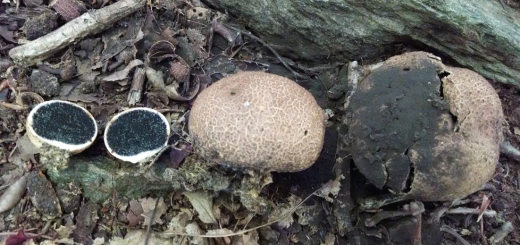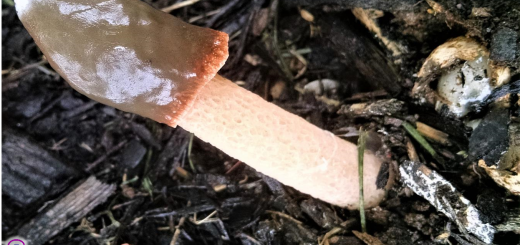#021: Pleurotus ostreatus, The Oyster Mushroom [Archived]
Note: This is an archived post. Read the current version of this post here.
The oyster mushroom is one of the few species of mushroom that you can routinely find at a grocery store. This is due to the fact that it is saprobic (it degrades dead plant material) and is easy to cultivate across a range of substrates. P. ostreatus will decompose pretty much anything with cellulose: from logs to sawdust to straw to toilet paper. Oyster mushrooms are often sold in grow-at-home mushroom kits, usually with a substrate like sawdust. In nature they are usually found on logs or standing dead trees. Occasionally you will find them growing terrestrially from buried wood. The Oyster prefers hardwoods, but can also be found on conifers. The name “Oyster Mushroom” refers to their shape and color, rather than taste. The fruiting bodies are semicircular to shell-shaped or fan-shaped, with a short or absent stipe. The upper surface of the oyster varies in color from gray to white. The taste can be mild to strong, and the mushrooms can smell sweet and/or like licorice. The Oyster’s spore print is white, but can vary to gray or lilac. P. ostreatus fruits in the late fall to winter. At UVA there is a half-dead tree next to Monroe Hall that routinely produces oyster mushrooms in early December.
One of the interesting things about Pleurotus ostreatus is that it will attack and kill nematodes. When nematodes are present, the Oyster’s hyphae will produce many secretory appendages on the side of the cells. These secrete nematotoxic chemicals that interfere with the nematodes’ mouthparts and paralyze them. The fungus then produces specialized hyphae that penetrate and digest the nematodes. There are two reasons that the fungus would do this. First, it is a defense mechanism that prevents the nematodes from feeding on the fungal cells. Second, the nematodes supply an extra source of nitrogen. The fungus does not need an extra food source, but nitrogen is frequently in short supply in dead material.
The name “Oyster Mushroom” actually applies to a species complex in North America. This is a group of three closely related Pleurotus species that have very similar morphologies. The complex is made up of P. ostreatus, P. pulmonarius, and P. populinus. As you might guess, the fruiting bodies of P. pulmonarius are lung-shaped, at least when young. This separates it from P. ostreatus, which produces mushrooms that are split into two equal parts when young. Perhaps a more useful distinguishing factor is that P. pulmonarius fruits from mid-summer to early fall. P. populinus is distinguished by the fact that it will only grow on trees in the Populus genus (aspens and cottonwoods). If you found your sample on a Populus sp. you’ll have to do some more work to determine which Oyster it is. However, you don’t really need to go through all that trouble if you are only collecting for the table. All three species are edible and taste roughly the same. Apparently the winter Oysters tend to have a more interesting texture and flavor. There are a couple look-alikes that you should look out for while collecting. The first is Lentinellus ursinus, the Bear Lentinellus. It has a similar morphology and habitat to the Oysters, but has serrated gills. Apparently it is “the only mushroom that raccoons will spit out.” This is because it has a very bitter and hot taste, which makes it unsuitable to eat. Other look-alikes to avoid are members of the Crepidotus genus. Crepidotus species produce a brown spore print, which easily separates them from Pleurotus. Although neither of these look-alikes is poisonous, they are not pleasant to eat.
See Further:
http://www.mushroomexpert.com/pleurotus_ostreatus.html









![#011: Characteristics of Kingdom Fungi [Archived]](https://www.fungusfactfriday.com/wp-content/themes/hueman/assets/front/img/thumb-small-empty.png)

6 Responses
[…] secretes toxins that paralyze the nematode before colonization by hyphae (part 2, 5:24, see FFF#021). Other fungi use normal hyphae to infect nematode eggs (part 2, 3:29). There are also a number […]
[…] which we are most familiar. The most common edible mushrooms (white/button/portabella mushrooms, oyster mushrooms, and shiitake mushrooms) are all gilled mushrooms. Amanita muscaria, the most recognizable […]
[…] mushrooms.2 Pleurotoid means “like Pleurotus” (as in P. ostreatus, the Oyster Mushroom, FFF#021), which also grows on wood, has gills, and has a rudimentary stipe.5 There are many mushrooms that […]
[…] means “like Pleurotus” and references the Oyster Mushroom, Pleurotus ostreatus (FFF#021). The Oyster Mushroom is the quintessential pleurotoid mushroom: it grows on wood, lacks a […]
[…] which we are most familiar. The most common edible mushrooms (white/button/portabella mushrooms, oyster mushrooms, and shiitake mushrooms), Amanita muscaria – the most recognizable mushroom in the world and the […]
[…] muscaria), the grocery store button mushroom and other varieties of Agaricus bisporus, shiitakes, oyster mushrooms, and even the major “magic mushrooms” are all basidiomycetes. However, basidiomycota also […]